Solana Blockchain - Crypto Academy / S4W4 - Homework post for Professor @pelon53.
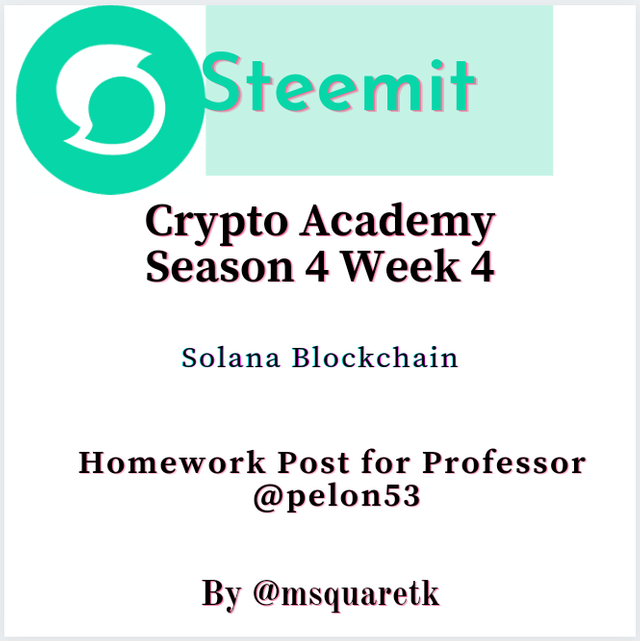
Cover Page created by me, @msquaretk | Canva App
It is week 4 already. Hello Stemians.
This homework post by me is submitted in response to the assignment given by Professor @pelon53 after his lecture on "Solana Blockchain." He explained that blockchain very well. So, I will be responding to the questions given in the next paragraphs. Follow me closely.

Question 1
Explain in detail the PoH of Solana
Firstly, PoH means Proof of History. Proof of history is a type consensus mechanism that's dependent on cryptographic way in creating authentic request of events and transactions on the digital ledger so that the issue of agreement will be solved and that as many transactions will be finalized even at very short time.
Proof of History was created by Solana, a blockchain that came into existence in the year 2018. This PoH was developed by a man called Anatoly Yakovenko. Proof of history in Solana enables the validators to reach agreement on time through the use of what is called VDF – Verifiable delay function. This proof of history, PoH has towerBFT which serves has "watchman", because it prevents any kind of cheating on the timestamp.
The Verifiable Delay Function used in solana is a kind of repellent hash function. The function takes multiple data as input and eject small output. The output is fixed in size. This function is very useful for security. And the uniqueness of it is that, you can't know the exact output until the entire function is carried out and executed, thus, it makes it very difficult to hack works of blockchain technology.
In Solana, data structure can be verified separately, because the hash function usually takes time before the block is formed. On receiving the structure of data to the decentralized network, all nodes accept the structure and don't have to verify them because of the authenticity and reliability of the ordering of the events being encoded in the blockchain.
Unlike other blockchains, where validators have to talk with one another to reach agreement on the time pass, in Solana, it is required that the validators conserve the clock, and this is done through solving verifiable delay function (VDF). When validators vote on a block, they must wait for a new block to be formed. There is going to a confirmation from the proof of history that "time has passed" , and when the validators receive this, they can now vote on the next block.

Question 2
Explain at least 2 cases of use of Solana.
In this part of the question, I'm going to be explaining two projects built on Solana blockchain. Let's start with the first one.
1. Mango Markets
Mango market is a leading exchange (cryptocurrency exchange) in Venezuela. The exchange is created by Alejandro V. Betancourt, who is also the CEO of the mango market platform. Mango market is a decentralized exchange platform which generates liquidity from serum, an exchange built on Solana blockchain.
Mango market use the combine the liquidity of Cefi and Defi at a very low cost to the user.This exchange provides a base for spot markets, futures and lending. The liquidity it generated is from its own pool and that of the serum which is the exchange built on Solana block chain.
Mango market aims at creating a market place where sellers and buyers would meet and come to an agreement on the price in a fair enough way and that their exchange will be secured through the use of digital currencies, cryptocurrencies.
The exchange has two order books. There's an order book for buyers and the other is for sellers. With the use of these two order books, People will see who are selling and at what price, and the buyers will buy if they agree with the price, and of course they their own freedom to buy at the price of their choice.
The official website of the mango market is https://mango.market. Upon clicking on the link, you will be directed to the homepage of the platform. In the homepage, there are about four features at the top.
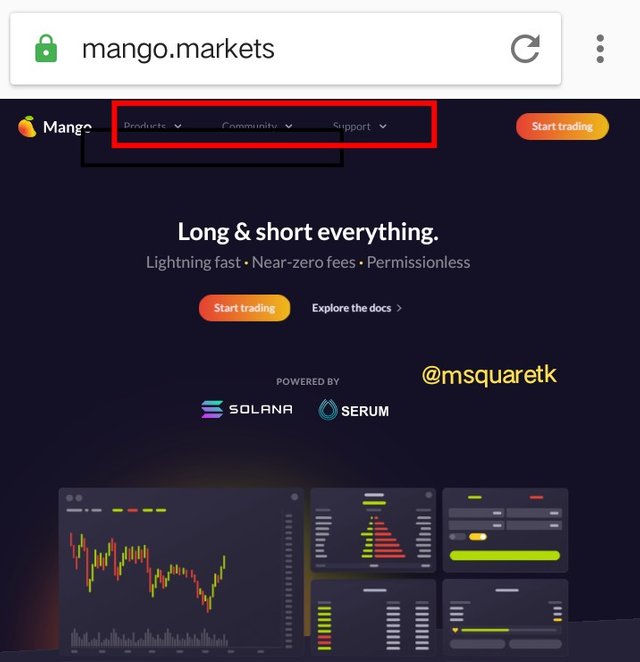
Fig. 1 : Mango Markets Homepage | mango.market
Now, at the top of the homepage, there are product, community, and support features. The product section is where to see market, infrastructure, Defi and Merch. We can see that this exchange has spot margin and perpetual futures under the market as explained above. You can lend and brow under the Defi* feature of the section.
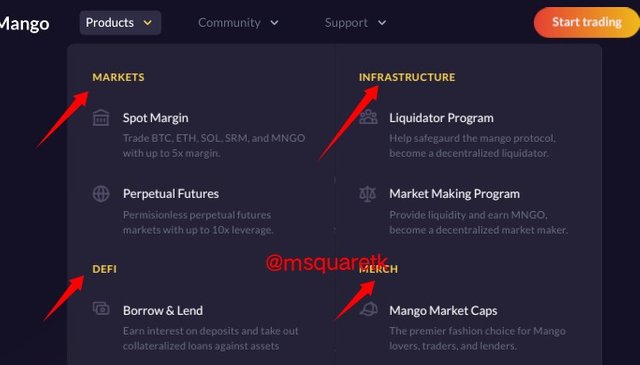
Fig. 2: Product Section in the homepage | mango.market
By clicking on the community, we will see some features such as developers, stat, governance.
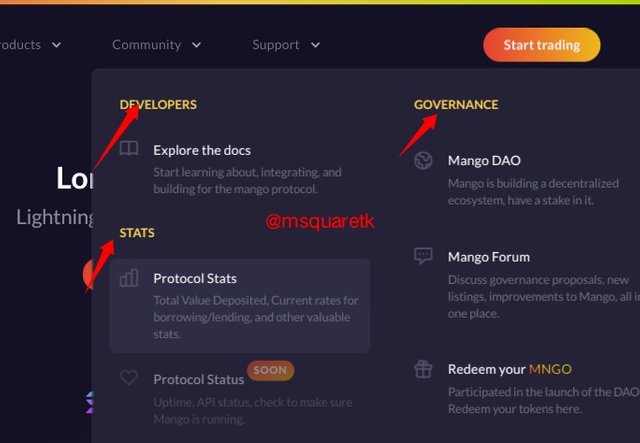
Fig. 3: Community Section in the homepage | mango.market
Also, clicking on support section, we will see various social media of mango market and the mango guides. See the screenshot below.
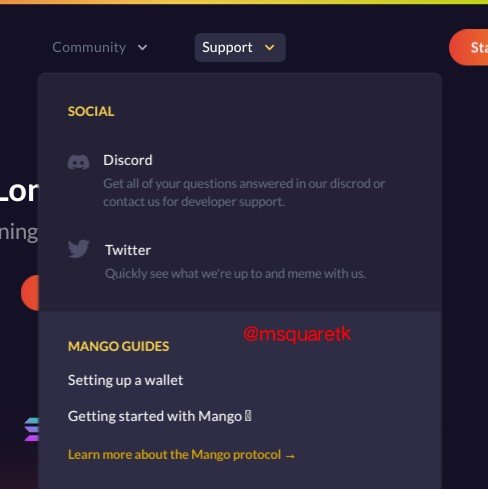
Fig. 4: Support Section in the homepage | mango.market
To start trading on mango market, click on start trading beside the support. .
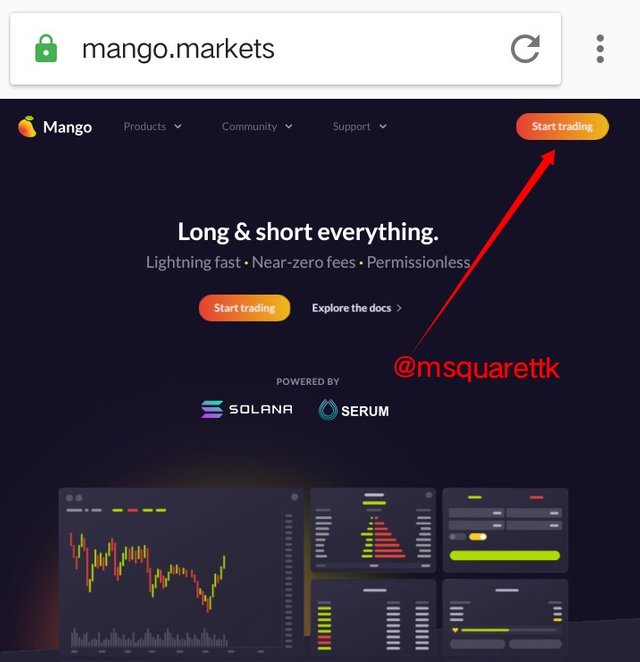
Fig. 5: Trade Icon in the homepage | mango.market
Once you click on it, accept the terms and conditions and then you will be taken to the trade page. See the screenshot below.
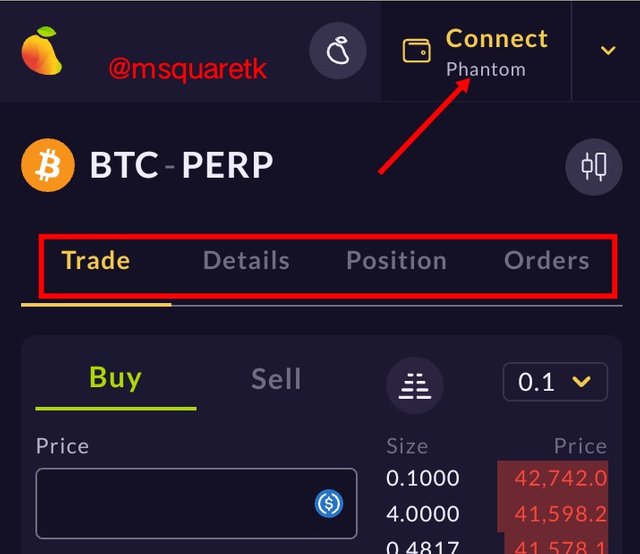
Fig. 6: Trade Page | mango.market
You have to connect your wallet before you can Start trading. At the top of the page in the screenshot above, click on connect. Upon clicking on it, you will see different wallets you can connect.
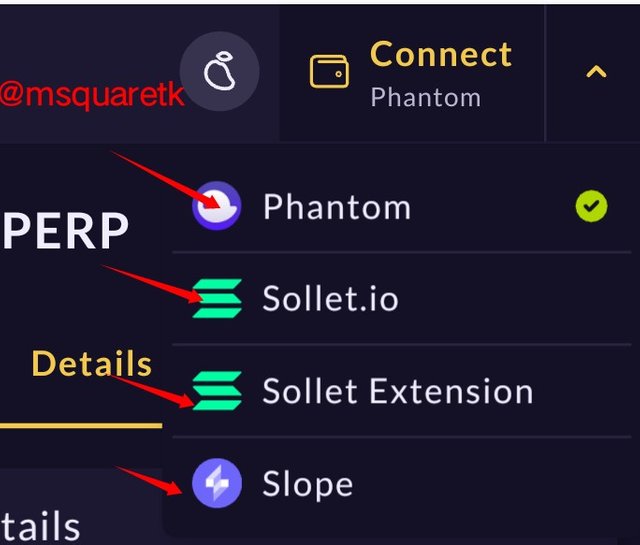
Fig. 7: Conmect Features showin different wallets in the Trade Page | mango.market
Connect any of the listed ones and then start trading.
Token
The mango markets has a token called mango markets token (MNGO). As at the time of writing this article, according to Coinmarketcap, MANGO has market capitalization of $307, 486, 881. Its current price is $0.3705 and has volume of $6, 064, 765. It is ranked 239 by coinmarketcap.
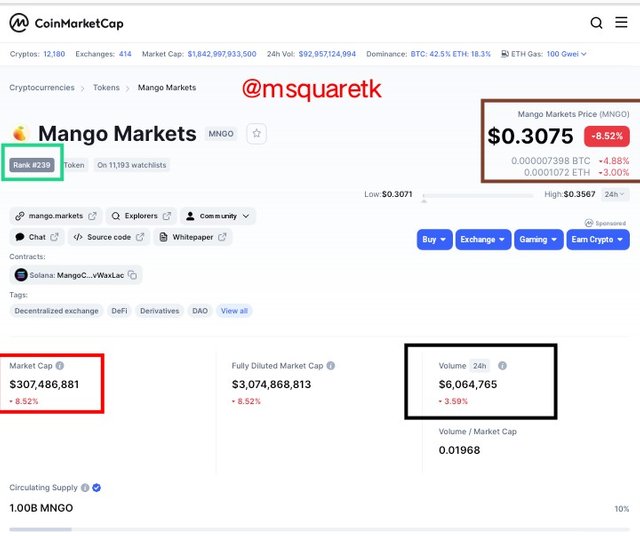
Fig. 8: Market Cap, Price, Rank and Volume of MNGO | coinmarketcap.com
MNGO is listed on many exchange platforms. The screenshot below shows MNGO markets.
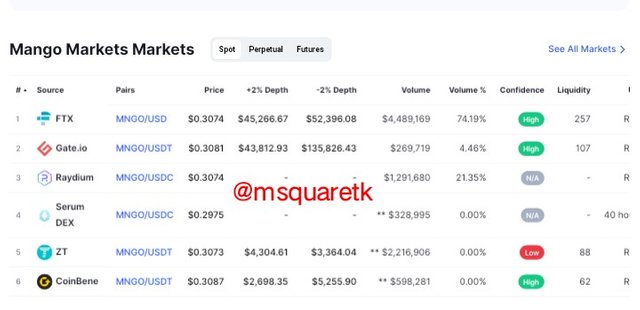
Fig. 9: MNGO Markets | coinmarketcap.com
2. Raydium
Raydium is another project built on Solana blockchain. Raydium is a decentralized finance application which is built on Solana blockchain which its usefulness is powering the Defi evolution. This platform offers an on chain liquidity to the order book which is central limit. And this makes raydium to be different from all other Automatically market maker (AMM).
Liquidity providers can generate reward by contributing from the trading fee.
According to research, the platform aims at partnering with other AMM (Automated Market makers) and Defis to build many projects on Solana block chain.
The platform has a token called Ray token. More on this later.
The official website of raydium is https://raydium.io. Upon clicking on that link, you will be taken to the website, the homepage of the site.
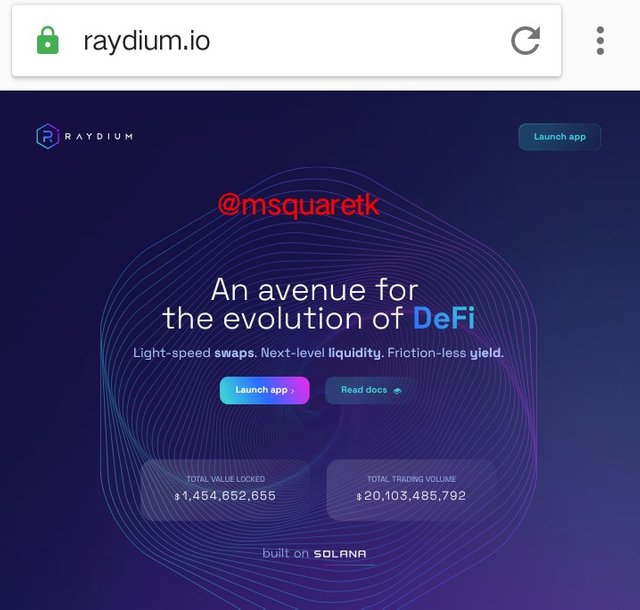
Fig. 10: Raydium Homepage | raydium.com
Scrolling down the page, there are features of this platform listed in a rectangular box. The features such as trade, pool, yield and acceleraytor.
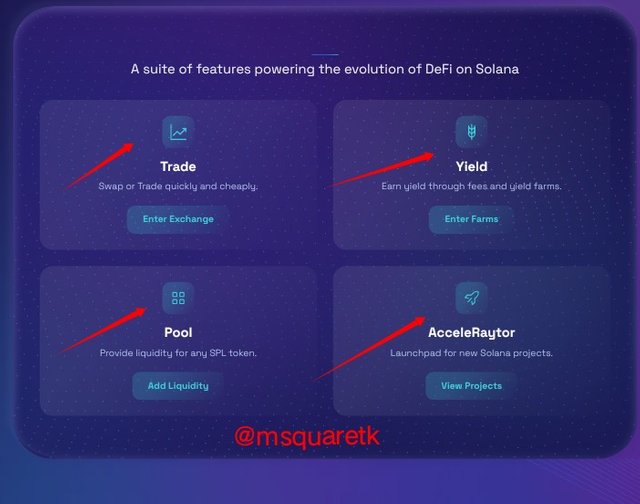
Fig. 11: Features on the Homepage | raydium.com
By clicking on the trade feature, you can swap token and exchange any coin listed with any other one on the site. You will have to select from the token you want swap and to where you want to swap it to. But,it is important to know that you will connect your wallet.
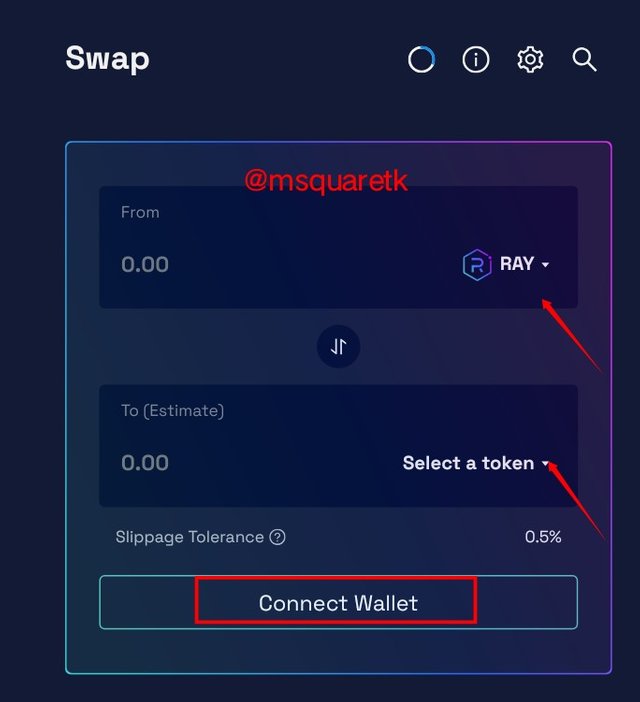
Fig. 12: Trade Section | raydium.com
To connect wallet, you will click connect. There alot of the wallet you can connect. Some these wallet are showing in the screenshot below.
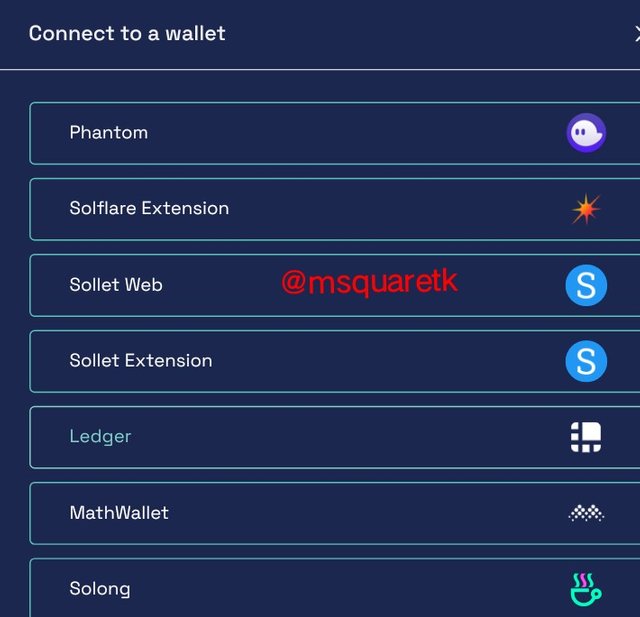
Fig. 13: Different Wallets that can be connected | raydium.com
Also, at the top of the page after clicking one of the features, you will see all other features. Just click on any you want to do.
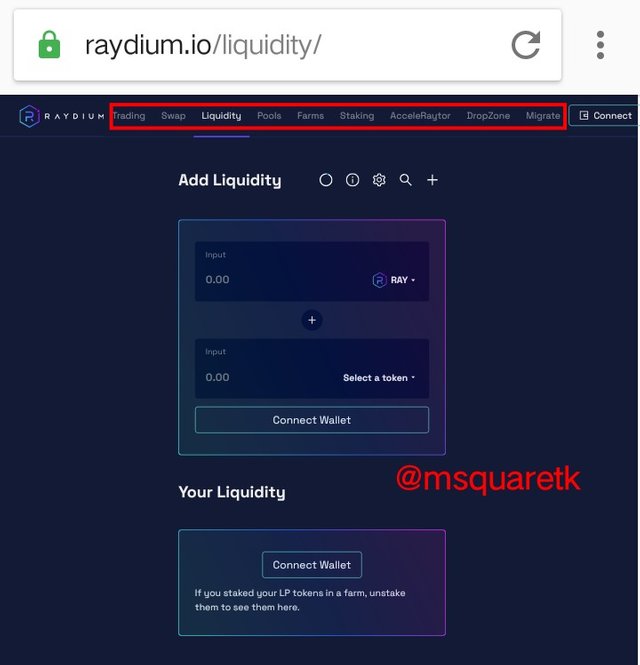
Fig. 14: Different Features | raydium.com
RAY
Ray is the native token of raydium. The token is used for three things. These are:
- Staking to obtain IDO allocation.
- Staking to make protocol fee
- Voting for governance to make decisions.
As at the time of writing this post, Ray price is $9.17, and has a market capitalization of $643, 017, 864, volume of $111, 894, 677 and ranked 110 by coinmarketcap.
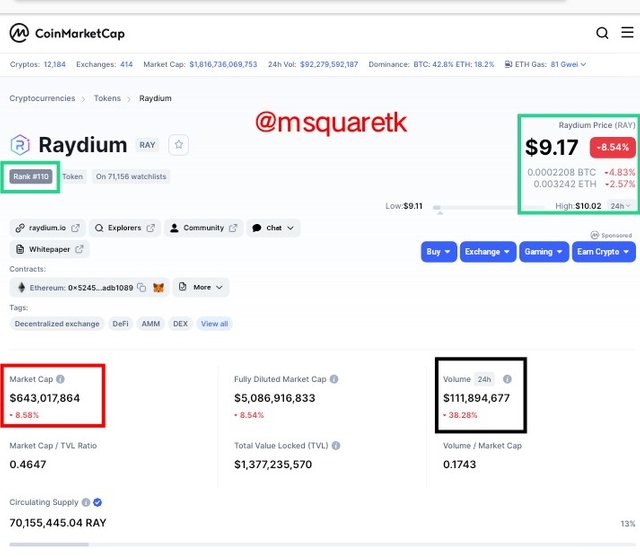
Fig. 15: Price, Market Cap, Volume, and Rank of Ray | coinmarkwtcap.com
Ray has been listed on different exchange platforms. Below is the screenshot showing RAY markets.
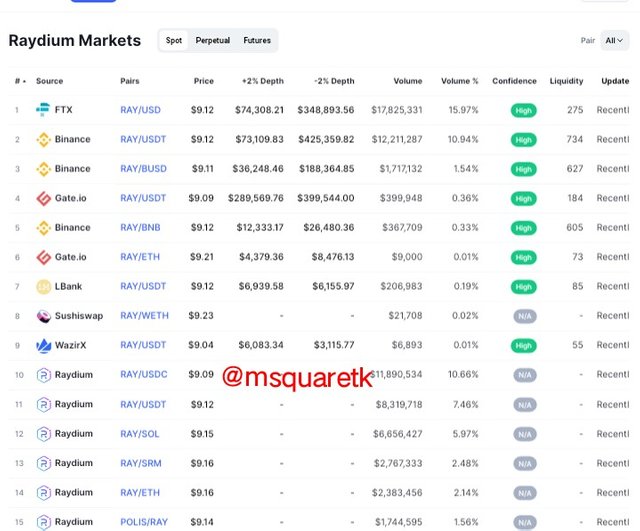
Fig. 16: RAY Markets | coinmarkwtcap.com

Question 3
Detail and explain the SOLA token
SOL is the native token of the Solana blockchain. The token is used for gas fee and it used to pay all transactions and smart contracts performed on the blockchain. SOL token was released to the public in the year 2020.
SOL is also used for staking. The holders of the coin when used for staking earn rewards. At least, they must stake 0.01 SOL so as to become a node which will be validating the transaction on the blockchain.
As the time of writing this post, according to coinmarketcap,
The current price of SOL is $135.
The market capitalization of SOL token is $40, 151, 344, 880
It's ranked 7
SOL token Volume is $2, 560, 221, 657
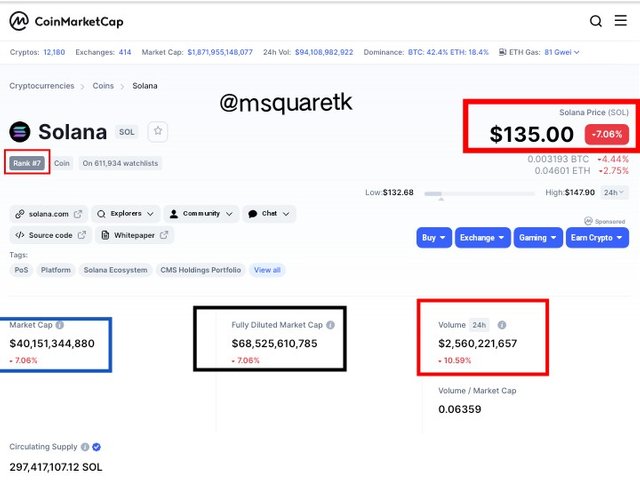
Fig. 17: Price, Market Cap, Volume and Rank of SOL by CMC | coinmarketcap.com
SOL has been listed on many exchange platforms, decentralized and centralized exchanges. The screenshot below shows SOL market.
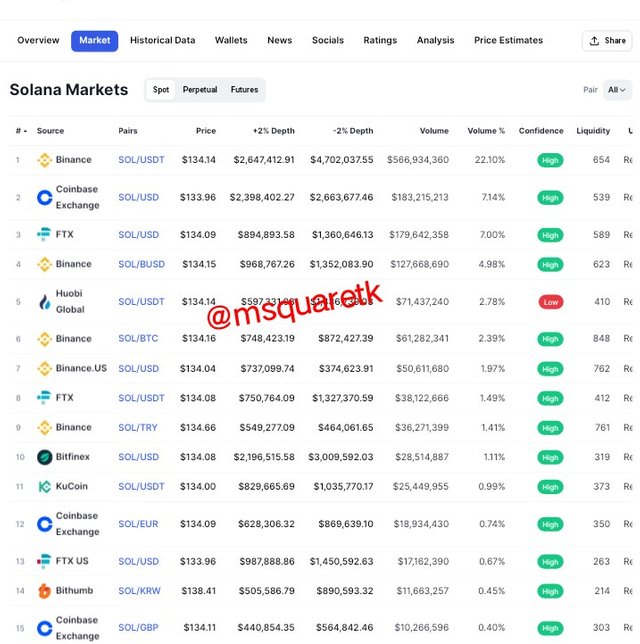
Fig. 18: SOL Markets | coinmarketcap.com
The all time low of the token is $0.5052 and this happened on the 11th of may 2020. Recently, SOL made its all time high of $214 on the 9th of September, 2021. Let's see the screenshot below
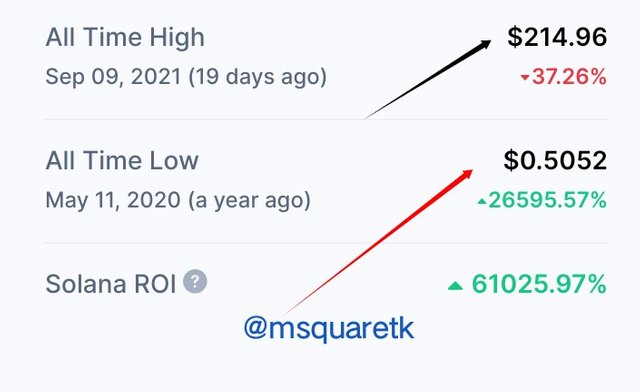
Fig. 19: All time low and high of SOL | coinmarketcap.com
After the all time high was made, the token has been correcting itself. Let's also the chart of SOL in the screenshot below.
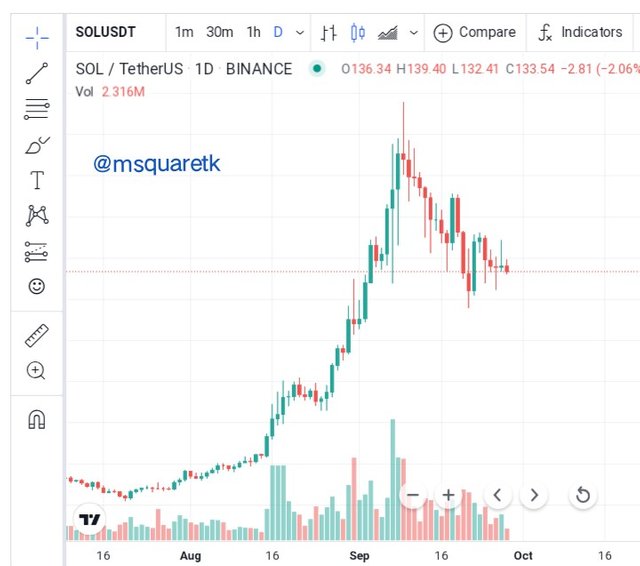
Fig. 20: SOL chart | coinmarketcap.com

Question 4
When did Solana Blockchain see its operations interrupted? Why? Explain.
There was interruption on solana blockchain on the 14th of September, 2021.
This interruption was due to the load exhaustion. The transaction reached 400, 000 transaction per second (TPS). According to research, the organizer came out the next day after the interruption to let people know what the cause of the interruption was. It's said that the cause of interruption was due to attack of denial of service. As said, the validators could not perform their function of validating the transaction on the blockchain as a result of Grape Protocol that launched her IDO on Raydium, and bots generated series of transactions which created network flooding and causes memory overflow which prevented validators from performing their duties.
The period of interruption lasted for about 17hours. During the period of interruption, no body could perform anything on the blockchain as it was stall. The investors' money was locked up. The native token of solana blockchain which has been in the uptrend, rising greatly since fell when this interruption occurred. Before the start of the interruption, the token was trading for an $171, but after the system was restored, it has fallen to about $142.
Identifying the problem, the engineers across the globe were writing code so as to bring the network back to normal after the solana community has decided to perform hard-fork on the blockchain. About 80% of the stake approved the proposal. Then after the agreement or consensus was reached, the upgrading started and it took about 2½ hours for the system to be restored back to normal and everything started working, the validators could now start performing their function.

Question 5
Check the last block generated in Solana and make an approximate calculation of How many blocks per second have been generated in Solana, taking into account from the initial block to the current one? Justify your answer and show screenshots.
For this part of the question, I'm going to be using solscan block explorer. So you can visit the website by clicking this link.
Upon clicking on it, you will be taken to the hospital of the block explorer.
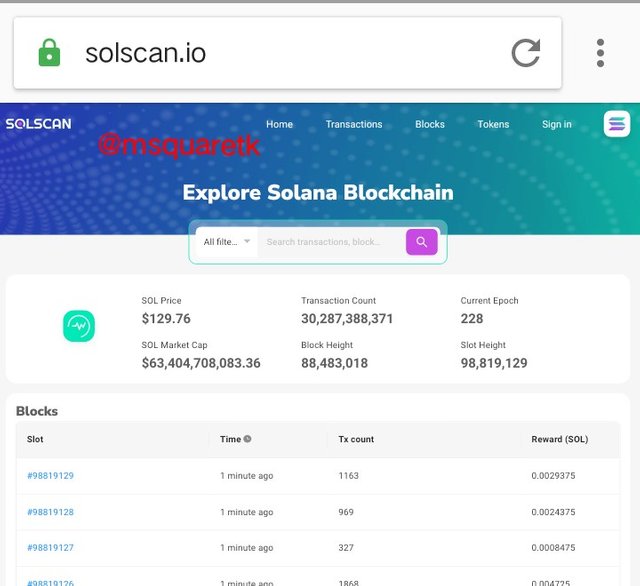
Fig. 21: Solscan Homepage | solscan.io
Scrolling down the page, a list of blocks being formed will be arranged in a column with the last block being at the top.
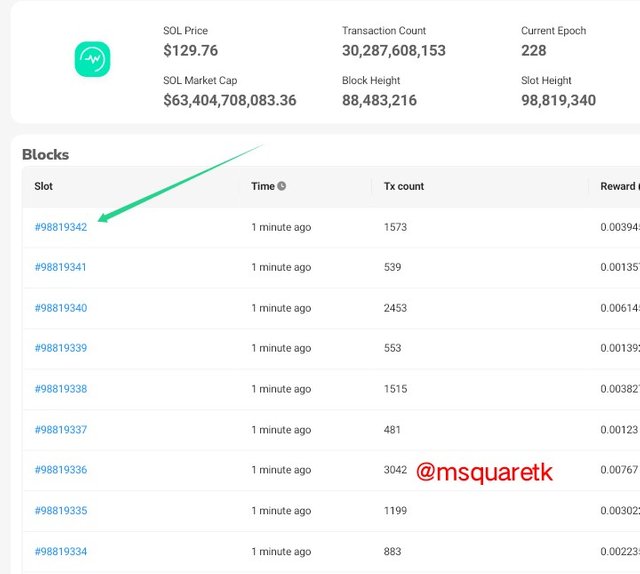
Fig. 22: Blocks on the Column | solscan.io
By clicking on the link block indicated with the red arrow in the figure above, we will see more details on the block.
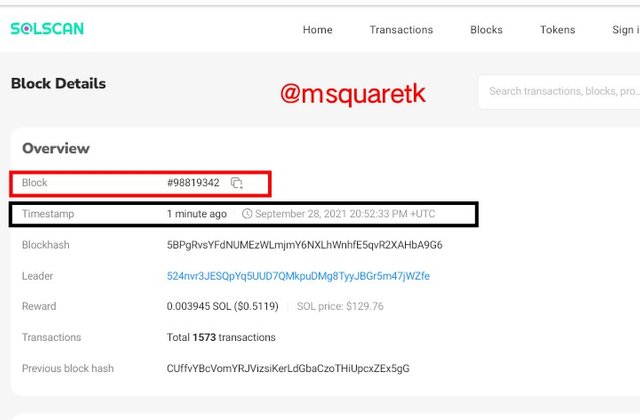
Fig. 23: Details of Last Block | solscan.io
As we can see from the screenshot above, the last block formed as the the time of visiting the block explorer is 98819342.
Now, to the calculation.
As it is known that it takes 0.5sec for a block to be formed on Solana blockchain.
In essence,
1 block formed at every 0.5sec
Now, let's calculate the number of blocks that has been formed per second.
If 1 block is formed at 0.5secs, then
2 blocks will be formed at 1 secs
Therefore the total number of blocks that will be formed if each block is formed per second will be:
98819342 / 2 = 494096671
Therefore, if the formation of a block is per second, the total number of block will be 49409671 blocks
Now, the next thing we will calculate is total time in seconds for 98819342 blocks to form.
Since a block forms at 0.5 sec.
Therefore, total time in seconds = 0.5 × 98, 819, 442
= 49, 409, 671 seconds
= 49, 409, 671 / 60 = 823494.52 minutes
= 823494.52 / 60 = 13724.91 hours
= 13724.91 / 24 = 571 days
= 571 / 52 = 81.57 weeks
= 571 / 30 = 19 months
= 19 / 12 = 1.6 year (1 year, 6 months)
So, from the calculation above, we can see that the blocks have formed for 1 year and 6 months. And the official launch of the Solana blockchain was in the month of March, 2020. And we are in the month of September 2021. From the launch month March 2020 to this time, September, 2021, it is exactly 1 year 6 months.

Conclusion
Solana blockchain has been popular because of its usefulness. Solana blockchain is one of the fastest blockchain which doesn't delay transaction. It can handle a bunch of transaction at a very small time. Each block is produced at 0.5sec. There are many projects built on Solana blockchain. I discussed two of the project in this article.
I find it a great privelege to attend this great lecture taught by Professor @pelon53. I have been able to learn one thing or the other from the topic and the project built on Solana block chain. Thanks Prof. @pelon53

Written by @msquaretk
CC: @pelon53